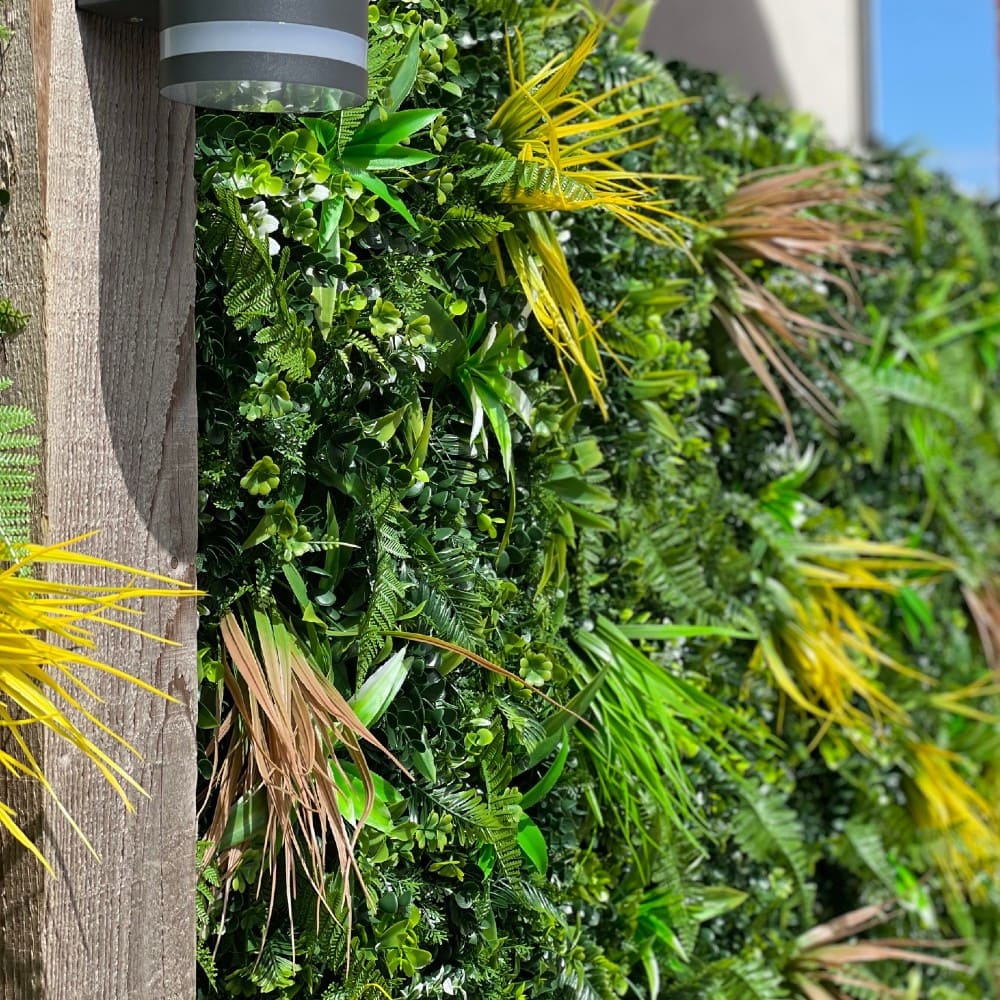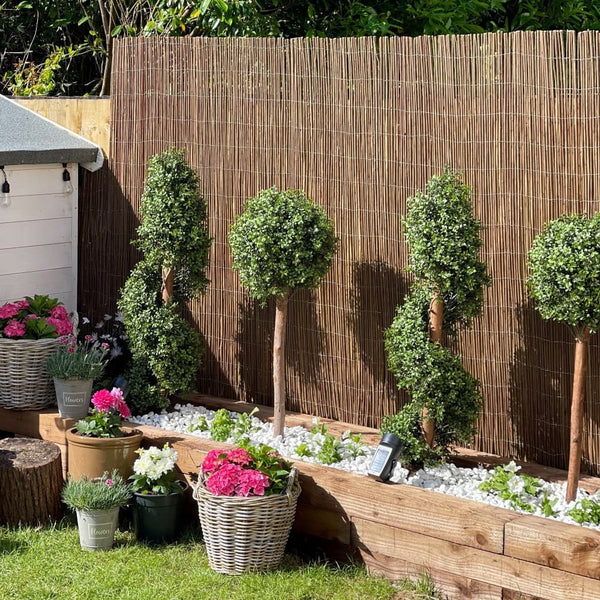
Everything You Need to Know About UV Resistant Artificial Plants & Trees
Artificial plants are the ideal way to bring that splash of nature to your home, workplace, balcony, or garden, but it’s important to remember that not all artificial plants are made equal. Some will work beautifully in a vase on your mantle for years, but if you move it to the windowsill where it is in direct sunlight, it may fast lose its colour.
So, why does this happen? Anything dyed needs to be protected from the sun’s UV rays if you want to keep it looking its best (just like our skin!). This doesn’t need to be a big deal, and it doesn’t even need to happen. You can choose or make your choice of artificial plants UV resistant so they’ll keep their beautiful colour and shape for many years to come.
If you are the owner of any number of artificial plants, you will know that they require far less upkeep than the real thing. Faux plants, flowers, topiary, and trees may be easy to keep, but there are still a couple of things that you can do to prevent them from fading over time. Read on to learn all about UV-resistant plants, how long they can last outdoors, and how to keep them looking clean, green, and fresh!
Why should I choose artificial plants over real plants?

There are several benefits of having artificial plants instead of real plants:
- You don’t have to invest a ton of time in maintenance – this is particularly important to those of us who spend a lot of time at work or would prefer to spend our time with our family or enjoying ourselves! Artificial plants rarely need more than a dust off.
- Artificial plants also have the benefit of not triggering annoying allergies, making them perfect for homes with pets and young children.
- Speaking of pets and children, artificial plants offer the added advantage of being far easier to clean up if knocked onto the floor. If a mischievous cat or excited child knocks over an artificial plant, you likely won’t have to deal with a huge amount of soil, and you almost certainly won’t have to deal with a broken plant!
- Artificial plants can also be a cheaper option than real plants: you don’t need to invest in expensive fertilisers, nor do you need to buy each plant a brand new pot every time it outgrows its current pot. Conversely, we generally kill 50-70% of the plants we bring into our homes, so there’s certainly a lot of money to be saved there!
- With faux plants, you can also place them in any part of your home or garden without worrying that they will receive too little or too much sunlight. There’s no concern of leaves burning to a crisp or the soil drying out. You also don’t have to worry about overwatering or underwatering. So, whether you want to brighten up a dark hallway, put some topiary outside your south-facing or north-facing front door, or inject some colour into a dull bathroom, artificial plants are an excellent option. British weather can be unpredictable at the best of times, but this is much less of a concern if your plants are artificial, particularly if they are UV-protected!
Do fake plants fade in the sun?

You may wonder why UV resistance matters when you’re choosing an artificial plant, but even fake plants need a little protection from the sun’s harsh rays. Just like real plants, trees, and people, too much sun is not always a good thing for artificial plants.
Certain artificial plants may fade in the sun, especially if they are exposed to extreme weather or long hours of sunlight. The length of time your plants last will also depend on the materials used to make them. For example, plants made of silk will usually only last you a couple of months in direct sunlight, potentially even less if you place them outside without treating them. After a few months, cheaper artificial plants may start to change colour, crack, and fade.
Most artificial plants are made from plastic. While the specific materials vary from plant to plant, the most common materials include polyester, sateen, polyethylene (PE), silk, polyvinyl chloride (PVC), and polyurethane (PU). That means that, unless they’ve been made or treated with UV protection, they will fade over time.
So what’s the science behind a fading artificial plant?
When an artificial plant is exposed to too much sunlight and hasn’t been treated properly, the energy from UV light will cause two chlorine molecules to break free, with the chlorine binding to the nearest molecule it can.
The chlorine molecule breaks the hydrocarbon, causing the formation of hydrogen chloride gas. When mixed with condensation, this gas becomes hydrochloric acid, which breaks down the colour pigments and structural integrity of the artificial plant.
The result is a discoloured and weakened plant that is vulnerable to further damage from UV light.
What makes an artificial plant UV resistant? Are there different types of UV resistance?

There are three primary types of artificial plants:
- UV-resistant plants: these have a chemical stabiliser or blocker sprayed onto them during manufacturing. This additional chemical absorbs UV rays and protects the plant’s structure and colour. If this stabiliser or blocker is applied to a plant during manufacturing, it will be referred to as inherently UV-protected. This early addition of the stabilisers, blockers, and absorbers will also mean that all of the foliage is equally protected from the sun. Sprays added after manufacturing may miss a spot, leading to patchy or inconsistent UV protection.
- Weather-resistant plants: these types of fake plants aren’t always protected from UV damage – they are typically made with plastic designed to withstand all weather types. Plants without UV protection often become a little fragile after a year or so, depending on how much sunlight they’ve been exposed to. If you’re looking at a weather-resistant artificial plant, make sure you check to see if it also has some UV protection.
- UV-infused plants: this type of plant is typically made with a Poly-blend material with an in-built UV protectant. UV-infused plants are the most durable as the UV protectant is built into the very fibres of the plant. UV foliage offers the highest level of protection, giving you the best value for your artificial plants, trees, and flowers.
How long do UV-resistant plants last?
If treated properly, UV-resistant plants should last for years. If left untreated, low-quality silk plants may only last a couple of months. If you treat artificial plants without built-in UV protection with a UV-resistant spray, you’ll need to respray the plants every so often to keep them looking their best.
How long will fake plants last outside?
If you want your plant to last a long time outside, make sure you choose one that is suitable for indoor or outdoor use. Pretty silk artificial flowers are beautiful, but they will fade and become damaged quickly if they are designed for indoor use only.
If you’ve bought a quality artificial plant, there’s no reason why it shouldn’t be able to stay outside 24/7, however, to keep them looking their best, you should consider bringing the plant inside (if possible) if there is going to be an extreme storm. This will ensure it doesn’t get damaged by winds.
Does UV spray work on artificial plants?
UV spray can be a worthwhile addition to your artificial plant collection, whether you’ve got just one artificial plant in your living room or several hanging topiary plants in your garden. A UV protection spray will mean that the protection layer is applied to the outside of the leaf, rather than being embedded inside the plant’s materials.
If you love the look of a specific faux plant, but it doesn’t come with inbuilt UV protection, sealant or spray can offer temporary protection to your artificial plants, but you will likely need to apply it every six months or so.
How do you keep artificial plants from fading?

You can slow down an artificial plant’s deterioration by rotating or moving them regularly. You don’t have to move it into a different room entirely, but if there’s direct sunlight exposure, you’ll want to shift it every few weeks or so – you’ll likely naturally do this as you clean your home. You want to make sure that if any fading occurs, it will show up all the way around your plant and look a little less noticeable.
For outside plants, just turn the pot every so often when the UV is especially intense, such as on bright, hot summer days. If your plant is UV-resistant, you don’t need to worry too much, but it’s worth doing to protect the longevity of the plant, where possible. Alternatively, use a UV spray on the side that is subject to the intense sun and spray it for additional protection. This is a good idea if you’ve planted your artificial plants or have a large artificial plant that cannot easily be moved.
To prevent a build-up of dust, clean your plants using a feather duster or a soft paintbrush. Dust your plants thoroughly to remove any dirt or dust that has settled. This will ensure that they look good and fade evenly if any occurs.
To keep your non-UV-stable plants from fading, you should also avoid putting them in south-facing areas. Plants that spend lots of time in a south-facing part of the home will be exposed to more sunlight, so the UV resistance will wear off, causing rapid discolouration. If you really want to place your plants in a south-facing part of the house, try to go with artificial pastel-coloured flowers or use a UV spray. With pastel hues, the discolouration will be far less obvious than highly pigmented tones like vivid red, hot pink, and royal blue.
Overall, the effectiveness of UV plant sprays depends on the type of spray used, how much is sprayed, and the total coverage of the plant. It’s good to note that some homemade sprays sometimes leave a sticky residue that can attract dust. For this reason, it’s usually worth investing in a decent spray if you can’t get your hands on an inherently UV-protected plant.
Final Thoughts
These days, faux plants are super realistic. Whether they’re made with a blend of plastics or silk, today’s technology means we can have artificial plants that look extremely similar to real plants. The only difference is that they require far less maintenance and can save you some money.
Artificial plants’ beauty is not weather-dependent; they look the same from summer to winter, providing the consistency you need for any great garden, balcony, or indoor plant collection. You don’t need to spend months waiting for your new golden pothos to spill out over its pot because your faux plant is as long as you want from day one!
As we’ve learned, there are many benefits to using UV-treated artificial plants: they stay green all year round, with no yellowing or fading. They’re less likely to crack and break if it gets hot outside, and some UV protection may even minimise a build-up of dust on your plants.
So why not look into some UV-treated plants next time you’re picking out a faux plant or tree for your garden, balcony, home exterior, or living room? Explore our range here.

Leave a comment